[回上頁 | 顯示此文件為可列印格式]
此文件提供者: shuYing - [評分 : 0.00 (0 票選) | 評分!]
Thai
Swamp Buffalo General Information
Supat Faarungsang
Department of Animal Science, Kasetsart University,
Thailand
Before 1971 the buffalo was a
very important domestic animal in Thailand.
Statistics from the Thailand agricultural statistical center showed that
Thailand had about 5.5 – 6.5 million buffalo during 1971 and 1981.
The buffalo population declined
to 1.8 million in 1999. Buffalo
could be extinct from Thailand in 20 years, if no considerable public attention
was received. There
are several reasons for the reduction in the number of Thai swamp buffalo:
1.
The reduction in the rice producing areas,
2.
The replacement
of buffalo by farm engines,
3.
The castration of good male buffalo to increase
carcass quality,
4.
The industry invasion into the Thai rural areas,
and etc.
From
1953 to 1971 the Thai rural areas were covered with buffalo because most of the
rural families had 2-4 buffalo. According the Thailand agricultural statistical
center (1971 – 1981),
Thailand owned the largest buffalo population and was the buffalo champion in
South East Asian countries. Today, and one would have to drive a car for a long
distance to find one buffalo.
Types
of buffalo in Thailand
There are three
types of buffalo in the world, the swamp buffalo (Fig. 1), the river buffalo and
Mediterranean buffalo. The swamp
buffalo is the indigenous buffalo in Thailand. The Department of Animal Science, Kasetsart University, was
the first official unit that introduced river buffalo into Thailand during 1957
and 1978. Most of the swamp buffalo
in Thailand are completely black in color. Only a few of them are white in color. The white buffalo are not albino but the color is due to
uncertain genetic effects. The dark
color makes the buffalo's look scary and most ladies are afraid of the buffalo
(Fig. 2). The dark color also makes
buffalo heat intolerant, which is why it must stay near the swamps (Fig. 3, 4).
On average, mature male buffalo weigh 450 – 600 kg in weight. The
mature females weigh 350 – 450 kg in average (Fig. 5). Thai
buffalo is longevity and prolificacy; female buffalo could have healthy
offspring even elder than 20 years old (Fig. 6, 7, 8).
Thai
swamp buffalo as a royal worker
The Thai swamp buffalo is
called “Ai Tui” in the Thai language which means, “it is an honest royal
worker” that is very important for Thai farmer life. The buffalo was considered a royal worker because no
comparable animals or machines could do the work as well as the buffalo.
Because it has big feet and is good at pulling with slow walking steps,
Thai farmers use them to pull rice-digging instruments for preparing the land to
grow rice. The buffalo was also used as a transportation animal (horses
are rarely used in Thailand up to today). Because
of its long terrible looking horn (Fig. 9) that sometimes becomes as long as 3
meters across both horns, the buffalo was also used in war.
However, most of today’s buffalo have short horns (Fig. 10).
The Thai swamp buffalo can be used to work up to 14 years old without
problems. That is very long royal worker life compared to other animals.
On average, the buffalo works 5 hours a day. In
one year a buffalo can help to grow 9.7 to 13.4 Rai of rice (1 Rai in Thai is
equivalent to 1600 m2). The
buffalo is used 122 days a year. In
the past, most Thai farmers grew only one rice crop in
a year. Today in the machine era,
we can have 3 rice seasons in Thailand each year.
After they are 14 years old the “royal worker” are sent to the
slaughterhouse. A buffalo carcass
will contain 40.8 to 46.4% based on live weight. Buffalo
carcass quality is inferior compared to cattle i.e. less in lean cut percentage,
less in dressing percentage, higher in fat percentage and higher in bone
percentage. This may be the reason
why farmers today prefer to raise beef cattle.
Buffalo
husbandry
Both
male and female buffalo were used as draft animals. Thai
children perform the buffalo husbandry duties and thus the “royal worker” is
also a friend to Thai kids. Because
of the deep friendship between the buffalo and kids, the buffalo becomes very
healthy and in good condition. The
pasture quality in Thailand is poor and barren (Fig. 11) but the buffalo is well
adapted to this condition. It is
able to eat everything refused by cattle. The
weeds in the swamp areas along the roads are a good source of food for buffalo
(Fig. 12). The buffalo is not only
a “royal worker” but also our weed controller and an ecological maintenance
animal (Fig. 13). The buffalo is
also a fertilizer maker because it produces an abundance of feces that is
fertile for the land. More
important than fertilizer, buffalo’s feces is free of the toxic chemical
residues found in commercial fertilizers that is harmful to the ecological
system.
Unlike river buffalo,
Thai swamp buffalo are very low in milk production. Buffalo are never milked for human food (even it was said that
buffalo milk is very high in quality with 12% white fat). Buffalo
meat in Thailand is a by-product because there is no buffalo meat production in
Thailand. For this reason there is
a lack of meat production data for
the buffalo in Thailand.
Relationship
between Thai farmers and buffalo
Thirty to fifty years ago was
the “buffalo golden age” in Thailand. During
that time 90% of the Thai population were farmers and they all had buffalo. Thai
people have deep relationship with the buffalo in the life. Several
Thai songs mentioned the relationship between farmers and buffaloes. The
buffalo era changed into the meat cattle era.
This change occurred very fast and made the buffalo an endangered animal.
Now, Thai custom compares a stupid person to a buffalo.
Because they think the buffalo are stupid animals instead of an honest
and royal animal. If it is said in
Thai “You are a stupid buffalo” most Thais will become angry.
Most Thai farmers today that
still have buffalo are not rich (Fig. 14).
Their home conditions are shown in Fig. 15.
Big farms belong to companies and raise beef cattle instead of buffalo
(Fig. 16). Thai farmers still keep
their “royal animals” next to their homes. In
the first Thai song that included at the end of
this paper ”the buffalo sleeps near the farmer during the night”.
The major food for Thais’ “royal animal” is rice straw (Fig. 17).
This is the by-product produced by the buffalo itself.
Of the buffalo produces the rice that is Thais’ food (the rice grain)
and eats the part that the human are unable to eat (the rice straw).
Do we abuse or take advantage of the “royal animal”?
Thai
swamp buffalo and the Thai cultures
Because
30-50 years ago there were a lot of buffalo in Thailand, the buffalo related
deeply to Thais’ life and became part of the Thai culture. There
were several Thai songs that talk about buffaloes and showed as
examples in Tables 1 and 2.
Table 1.
Smell of mud and buffalo song (composed by Mr. Paiboon Butrakhan)
|

|
|
We should not look
down on our Thai farmers. Their
life was hinged on rice growing in rural areas.
Thai life was tough and the farmers worked under the strong
sunshine. Their skin was
burned and became dark in color. However,
they never complained about that. Near
their homes the buffalo slept and a muddy smell always reached their
noses. However, they slept in a good dream. The young male and female farmers were also covered with
the muddy smell from the buffalo. Conversely,
the Bankokian who lived like in heaven always had the smell of good
perfume. That is a big
difference from the Thai farmers. Please
don’t look down on the Thai farmers.
Their hands are always busy with a tool to cut the rice grain to
feed us. Life is always a
valuable thing, because the farmer worships on the muddy buffalo smell.
|
Table
2. Bringing buffalo to their place
song (all right reserved by Kasetsart University, Thailand)
|
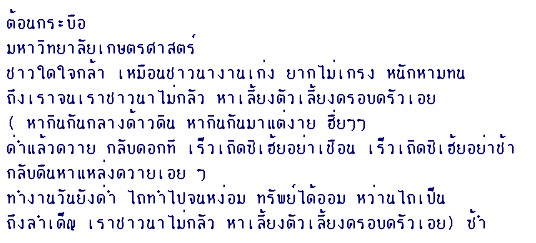
|
|
No one is as brave as
the farmer. They are never
afraid of hard work. They are
very durable and patient with their hard work. Although
they are not rich they are never afraid of that. They always earn money for their family.
They start to work on the ground before sunrise and stop their work
after sunset. After sunset
they shout “Huei Huei Huei Huei”, the magic words to bring their
buffalo home. They want the
buffalo to move fast but the buffalo keep moving slowly and clumsily.
They repeat the same job everyday since they were young until they
become very old. They deposit
their income on their land. They are able to grow rice by keeping on practicing.
Their life is tough but they are never afraid of that.
They always have to earn money for their family.
|
The
story about the Bangkokian (a Thais who lived in Bangkok), afraid of the buffalo
when they visit a rural area, is repeated in Thai movies.
The Bangkokian always wears colorful cloth.
When they meet the buffalo face to face, the Thai words “berng” is
used to describe this situation. It
means that the buffalo and human are looking face-to-face and eyes-to-eyes (Fig.
18). Most of the time the
Bangkokian will be frightened because they are always thinking that the buffalo
will become angry with them. So
they run away. Actually, no one knows what the buffalo really thinks.
The buffalo is colorblind. So,
there is difference in color of the clothes that the farmer wears or the clothes
that the Bankokian wear for the buffalo. Perhaps,
the reason the buffalo keeps on looking at the Bangkokian is their strange
behavior. Who knows? This phenomenon might also occur in other countries.
However, it occurred so often in Thailand that it became part of Thai culture.
References
Tumwasorn, S. 1979. Buffalo
production. Department of Animal Science, Kasetsart University.
Faarungsang, S. 1979. Buffalo
feed. Buffalo bulletin. Department
of Animal Science, Kasetsart University.
Voranvan, C. 1984.
Dairy Production. Thai Wattana Panich Publ., PP. 365.
Chakriyrat, S. 2002. Artificial
Insemination of Cattle and Buffaloes. Kasetsart
University Publ., PP. 439.
|

|
|
Fig.
1. Typical short horn buffalo
|
|

|
|
Fig.
2. Long horn and dark color
buffalo
|
|
|
|
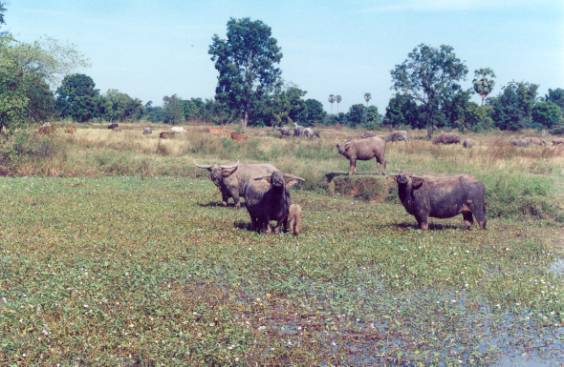
|
|
Fig.
3. Cows near swamp but
buffalo in the swamp
|
|
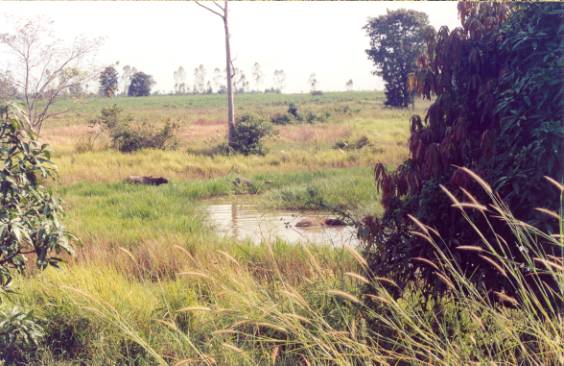
|
|
Fig. 4. Buffalo
loves playing in swamp
|
|
|
|

|
|
Fig.
5. How heavy are they?
|
|

|
|
Fig.
6. A 21-year-old long horn
buffalo with healthy buffalo kid
|
|
|
|

|
|
Fig.
7. Back view of old long horn
female buffalo and buffalo kid
|
|
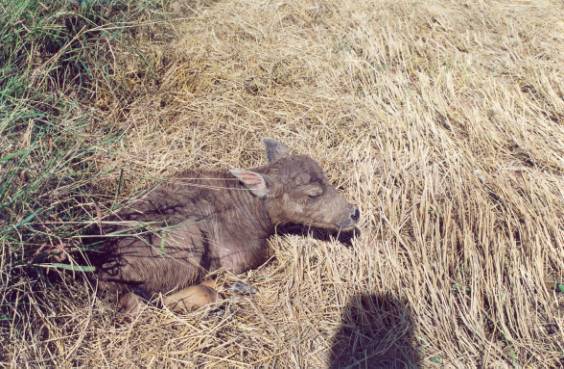
|
|
Fig. 8. A
Thai buffalo kid
|
|
|
|
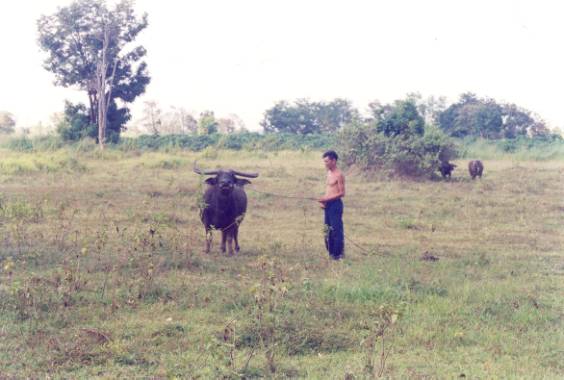
|
|
Fig.
9. Thai long horn buffalo
|
|

|
|
Fig.
10. Short horn buffalo
resting under tree
|
|
|
|
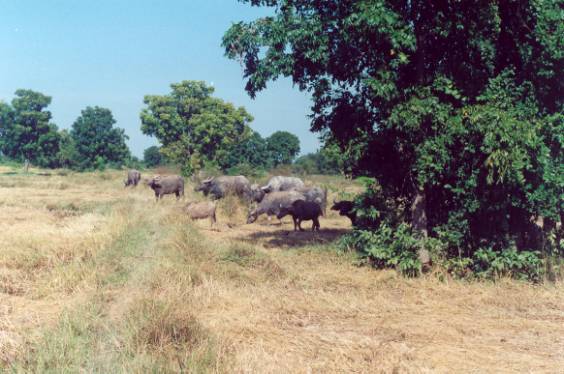
|
|
Fig.
11. The buffalo is adapted to
low quality pasture as well
|
|
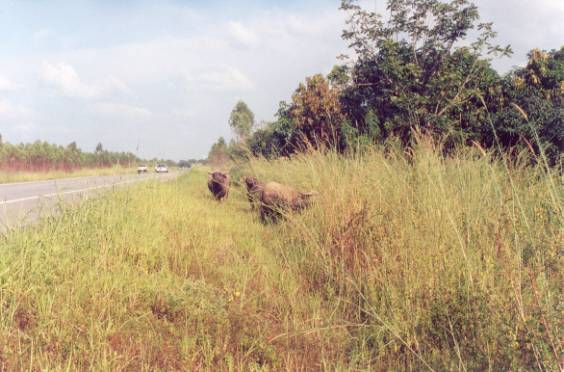
|
|
Fig.
12. Buffalo along the road
near Srakaew province
|
|
|
|
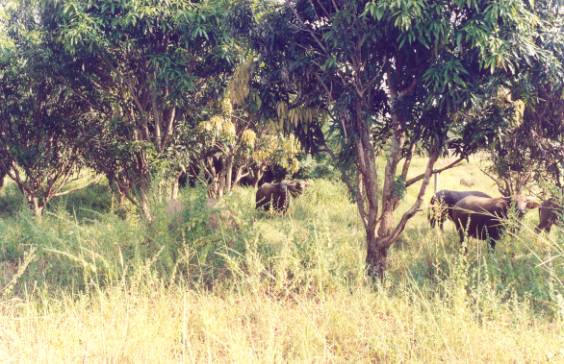
|
|
Fig.
13. A natural weed mower, buffalo, in mango garden
|
|
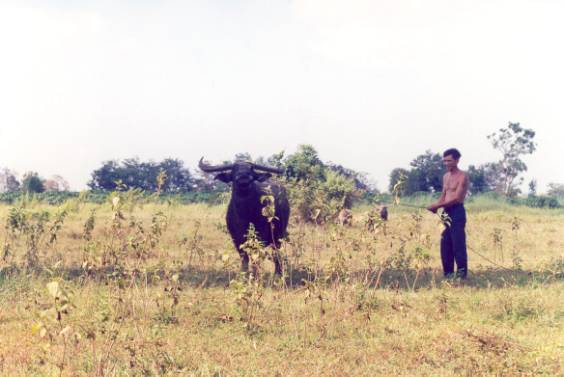
|
|
Fig. 14. Healthy and smiley buffalo owner
|
|
|
|

|
|
Fig. 15. Buffalo
owner’s home
|
|
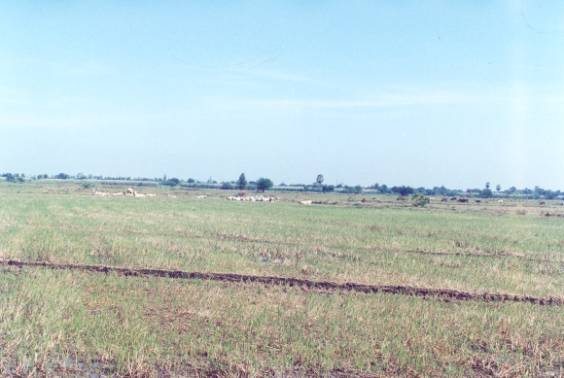
|
|
Fig.
16. Large-scale beef cattle
farm in the central Thailand
|
|
|
|

|
|
Fig.
17. Rice straw heap, low is
nutrients but the buffalo can thrive on it
|
|
|
|
Fig.
18. Look out.
Is the buffalo going to attack a colorful dressed person?
|
[回上頁 | 顯示此文件為可列印格式]
此文件提供者: shuYing - [評分 : 0.00 (0 票選) | 評分!]